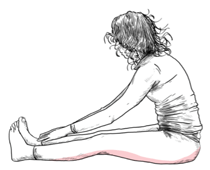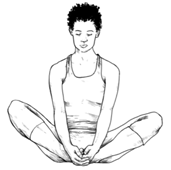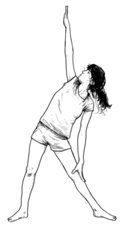
Yin Yoga is a simple practice, very simple.
Just come into a pose, become still and stay. Stay! Stayyyy.
But, for anyone who has tried this simple practice, you soon discover that “simple” does not mean “easy.” It is sooo simple that anyone can do it—but should anyone do Yin Yoga? Even beginners, who have never done any yoga before?
This is a difficult question to answer until we define our terms: what do we mean by “beginner”? To say someone is a beginner at yoga is not all that helpful. There are beginners who are naturally very flexible and will have no problem doing the postures being described, but there are beginners who are very inflexible and will struggle with many poses.
There are also beginners who are naturally very distracted mentally and will find it hard to stay present, and there are beginners who are very grounded and present and will have no problem with the mental requirements of a yoga practice. Students will have different combinations of these attributes: some will be flexible and grounded and these so-called beginners will have no problem with a Yin Yoga practice, while others will be inflexible and distracted and these students may be highly challenged by Yin Yoga.
It is this latter category that concerns teachers the most—should a student who is inflexible and/or unable to stay present start his yoga journey with Yin Yoga? That is the real question. The student who is grounded and flexible will have no problem, even though she is new to yoga.
Years ago, I had my doubts—I was not sure that beginners to yoga should start their journey with Yin Yoga. My fears came from a worry that a beginner would not know enough to come out of the posture when the sensations became too intense, that they might stay too long and hurt themselves.
I have since discovered that this was selling people short. Everyone knows what pain is, what they don’t know is how to pay attention to the more subtle sensations that arise in yoga asanas. I have found more yang students (doing regular hatha, vinyasa or hot yoga) get injured than the students coming to the slow-paced yin offering.
Injuries can happen in any style of yoga—even Yin Yoga—but getting out of bed can also hurt people. This doesn’t mean we should never get out of bed! It means we must practice with presence. We must pay attention to minimize any risk of injury.
Imagine the following: 
You have never done any yoga before and for your very first experience, a friend brings you to a Yin Yoga class. The teacher asks you to come into something called a Butterfly—she suggests sitting up on a cushion with your feet together, allowing the knees to fall apart, and folding forward until you naturally stop. Now, while you stay in this simple posture, the teacher describes who should be careful of this pose and what to do if you have any back issues or sciatica problems.
She takes the time to explain why you are doing this practice and how to do the practice. After this first posture, she offers you another pose: the Half-Butterfly, similar to the first pose, but one leg is straight, the other leg bent, and you fold over the straight leg.
She explains that the targeted area for this pose is the spine and the back of the legs.
You look around and see what others are doing and try to copy them. You notice your teacher as she comes over to you and asks, “What are you feeling?”
You don’t know: you are a beginner, so you probably say something like, “fine.”
She smiles and says, “I am fine too. But now tell me, not how you feel, but what you feel.”
Again, you are not sure. What does she mean?
She notices your hesitation and then clarifies her question. “Are you feeling anything along your spine or the back of your straight leg? Anything in the bent knee?”
You, for the first time, start to pay attention to these areas, scanning them with your mind. You point to your back and say, “I feel some tightness here.” And then you add, unnecessarily, “I am very stiff.”
Again your teacher smiles and says, “That’s why we do yoga! So, you feel some sensation in your back. Can you describe it?”
You are not so sure but you try to describe it, “its tight…”
“Good,” comes the response, “Pay attention to this area. If it ever gets painful, if you feel anything sharp, burning or stabbing, or if you ever feel a tingling, almost electrical feeling, stop and come out. But if it feels more like a tugging sensation, don’t be concerned. We are going to exercise this area and we want to feel something. Monitor it: if it feels muscularly engaged, relax it, but make sure it doesn’t become too much, or painful. Also, notice if the sensation ebbs and flows, if it goes away, if another area becomes more noticeable … if so, explore that sensation. The key is to pay attention!”
As your teacher leaves to guide the class to the next posture, you are aware of something else: you have begun to learn how to do yoga.
One of the big benefits of a Yin Yoga practice is precisely this ability to pay attention: in the yang forms of yoga, we are only in a posture for a short period—five breaths, or maybe a minute or so.
In Yin Yoga we literally marinate in the juiciness of the pose, and pay attention to the flow of sensations. Yin Yoga gives us a chance to learn what sensations are, where they are, whether they are healthy, albeit challenging, or too much.
We learn what an edge is, which is something that can be missed entirely in our yang practice. In the yang styles of yoga, especially for beginners, we are worried so much about all the details of the postures: the alignment, the muscular engagements, the teacher’s directions, the breath, the bandhas … With Yin Yoga, we have time to learn how to pay attention to sensations, to our edge.
In Yin Yoga, the student is given the time and guidance needed to experience their body and the effect on their body that the postures create. With this training, they will know when they have reached a good edge. They can develop their own sensitivity to what they need, when to go deeper and when to back off. With this entry into yoga, the student will be well equipped to join the faster-pace yang forms of yoga.
The greatest gift a teacher can give her students is the ability to know their own body, their own heart, their own mind—and the ability to develop their own practice.
Regular Hatha practice certainly can develop this skill, but when a student is holding a pose for only five or eight breaths, there is only enough time to worry about the physical arrangement of the limbs. “Am I doing this right?” is a question that beginners often ask. The answer the teacher gives should be, “I don’t know … what are you feeling?” Alignment and other cues should be secondary to the experience of the posture and its edge. With a student starting her yoga journey with Yin Yoga, she will get training in this important first step.
Yin Yoga offers a great way to begin a yoga practice, one that can branch out in many directions, one that can last for the rest of your life. Yes, beginners definitely can start their yoga journey with Yin Yoga.
Love elephant and want to go steady?
Sign up for our (curated) daily and weekly newsletters!
Editor: Renée Picard
Illustrations: courtesy of the author

 Share on bsky
Share on bsky







Read 1 comment and reply